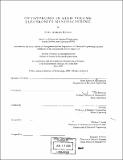Outsourcing in high volume electronics manufacturing
Author(s)
Ryden, Carl Ashley, 1971-
DownloadFull printable version (3.275Mb)
Other Contributors
Leaders for Manufacturing Program.
Advisor
Sara Beckman and Al Drake.
Terms of use
Metadata
Show full item recordAbstract
Outsourcing and subcontracting of manufacturing is growing at an incredible pace. According to a November 1998 Dataquest survey, the Electronics Manufacturing Services (EMS) industry is forecast to grow at a compound annual rate of over 26%. The largest and best known of the EMS providers, Solectron of Milpitas California, has recorded an astonishing compound annual growth rate of more than 53% since 1992 according to Chief Financial Officer Susan Wang. Despite the growing use of contract manufacturers, the decision to use them remains, in many organizations, a tactical one. Decisions to outsource are often undertaken solely within the manufacturing organizations within these firms, and focus primarily on reducing capital expenditures and direct costs such as labor. These decisions rarely take into account the much broader strategic implications of outsourcing a portion of the firm's production. This paper examines outsourcing decisions and their financial, organizational and, most importantly, strategic effects on the organization. It presents an integrated approach to making outsourcing decisions, a set of quantitative tools for assessing outsourcing options, and guidelines for implementation and management of the outsourcing relationship. The goal of the thesis is to enhance the overall quality of manufacturing outsourcing relationships by ensuring coherence with overall company strategy and strong execution. The work in this paper is based on a six-month internship as part of MIT's Leaders for Manufacturing Program in the Consumer Products Division of Qualcomm, Incorporated in San Diego, California. The learning presented in this paper is based upon observations made during the Qualcomm internship and an in-depth review of the literature on outsourcing. Because the work was done for Qualcomm, the findings of this paper are best suited to outsourcing decisions in similar organizations, those producing high volume, high-tech consumer products. However, many, if not all, of the underlying concepts are applicable to outsourcing decisions across a broad range of industries.
Description
Thesis (S.M.)--Massachusetts Institute of Technology, Sloan School of Management; and, (S.M.)--Massachusetts Institute of Technology, Dept. of Electrical Engineering and Computer Science; in conjunction with the Leaders for Manufacturing Program, Massachusetts Institute of Technology, 2000. Also available online at the MIT Theses Online homepage <http://thesis.mit.edu>. Includes bibliographical references (p. 54-55).
Date issued
2000URI
http://theses.mit.edu/Dienst/UI/2.0/Describe/0018.mit.theses%2f2000-55http://hdl.handle.net/1721.1/34699
Department
Leaders for Manufacturing Program at MIT; Massachusetts Institute of Technology. Department of Electrical Engineering and Computer Science; Sloan School of ManagementPublisher
Massachusetts Institute of Technology
Keywords
Sloan School of Management., Electrical Engineering and Computer Science., Leaders for Manufacturing Program.